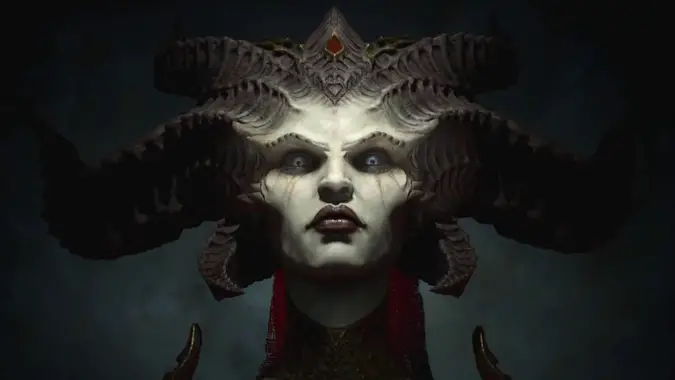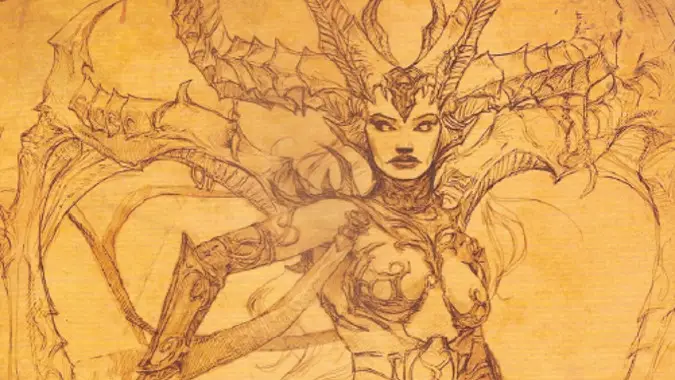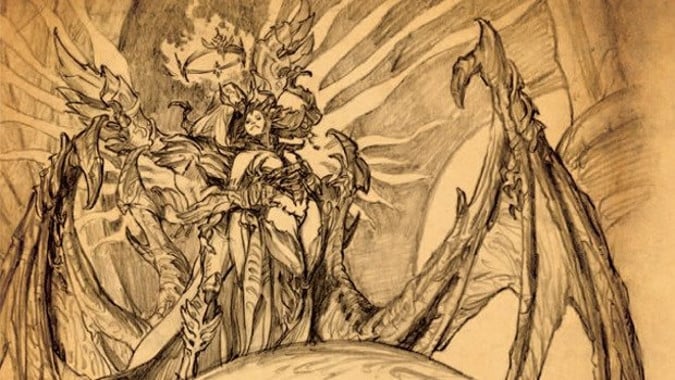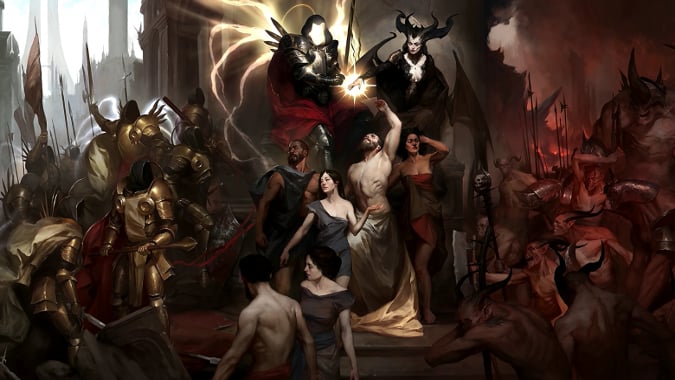Is Lilith the villain of Diablo 4?

Strictly speaking, the question, “is Lilith the villain of Diablo 4?” can be answered, “yes.”
Lilith is the villain because she’s the being whose plans kick off the whole game. Lilith is the protagonist we find ourselves in the position of trying to foil. Lilith is the villain because there’s an achievement for killing her.
Lilith is the villain because, frankly, Blizzard says she is.
The problem is, if you’re playing the game, it can really feel like there’s another candidate for the game’s villain. This isn’t to say that Lilith is a good being, or that the things she does are always beneficial to everyone involved. But there’s certainly room for nuance here, and it has to be said that so far, out of every villain that the Diablo series has ever had, this is the first one with not only a somewhat sympathetic point of view but also some really good points about the state of affairs in Sanctuary up to this point.
There will be spoilers for the first Act of Diablo 4 in this post.

What makes us doubt that Lilith is the bad guy
Our shade of gray in this scenario requires a bit of a trek through Diablo lore to set up.
Eons ago, Lilith — a powerful Demon and the daughter of Mephisto, the Prime Evil of Hatred and one of the three most powerful Demons in existence — decided that the war between Angels and Demons was pointless. She watched as the hosts of Heaven and Hell clashed repeatedly, neither side ever holding a true advantage. It dissolved into a quagmire of trading the Pandemonium Fortress that held the Worldstone back between the Demons and the Angels. One side would take it, then hold it, then the other side would storm the Fortress and take it back.
After centuries upon centuries, Lilith had decided that this was madness. They kept repeating the same cycle over and over again. The Eternal Conflict, as both sides called it, was only Eternal because both sides refused to understand how pointless it all was. Upon meeting Inarius, an Angel who shared her view of the conflict’s futility, Lilith could see a way to end the war once and for all, in the only way that wars tend to be ended — with a victor. She and Inarius each lured dissenters from their respective sides of the war together into one and attacked the Pandemonium Fortress, ‘stealing’ the Worldstone by using its power to create a pocket reality and hiding the powerful artifact of the time before Heaven and Hell existed within said pocket world.
That pocket world, inhabited by the rebel Angels and dissenting Demons, became known as Sanctuary because most of them saw it as a refuge from the Eternal Conflict. For them, the whole plan was to use the Worldstone, create a Sanctuary, and hide forever from the war that would never end. They lacked the vision that Lilith had.

Lilith is a loving, if somewhat dangerous, mother
When you play a Diablo game, you play as a Human. It’s the only playable race in the game series. We learn more as we play through the Diablo games and especially if we happen to be nerdy enough to read the tie-in media like the Sin War Trilogy. It turns out that Lilith’s plan for Sanctuary was for the world to serve as a creche, a place for her to take the next step in her plan. Neither Angels nor Demons could win the continuous warfare, but what about beings who were both?
So Lilith seduced Inarius, and in so doing, bore him a child — the infant Linarian, who would become known better as Rathma, first of the Necromancers. Other Angels and Demons followed suit, whether out of boredom or actual affection is never really discussed. And these children of the self-exiled were quickly revealed to be mighty indeed. These Nephalem walked the world of Sanctuary with heavy footfalls, and their Demonic and Angelic forebears beheld them with fear.
In their reaching out to the cosmos with unknowing hands, these Titanic beings threated to catch the eye of the Angels or Demons, drawing attention onto Sanctuary and bringing the Eternal Conflict to the refuge world created specifically to hide from just that. They went to Inarius and petitioned him to, well, kill off their various godlike children. This was because Inarius was the one linked to the Worldstone, and so could use its power against the Nephalem.
This was not an idea Lilith was prepared to accept.

So who’s the real villain, then?
Without going into even more of a lore hole than we already have, let me simply say that Lilith killed the Angels and Demons before they could kill the her children, the Nephalem. She revealed her plan to Inarius — no Angel or Demon could possibly win the war, but could an army of beings with the power of each be master of them both? Disappointingly, Inarius chose not to listen, banished Lilith into some prison created by the Worldstone no one could reach, and used that cosmic artifact to change the nature of Sanctuary so that the world suppressed the Nephalem’s power. From their perspective, each new generation after the Ancients was less and less, well, them. They became weaker, smaller, and finally ended up as Humans. Still descended from Angels and Demons, but without all of the awesome power that the first Nephalem like Rathma, Bul Kathos, or Fiacla Gear once demonstrated.
This led to the Sin War, as the Worldstone slowly weakened over time and Inarius’ inattention. Humans began to regain their power, the Prime Evils noticed, and the Eternal Conflict did indeed find Sanctuary. Lilith briefly managed to return and start to shape Humans into the army she had always intended them to be before being banished again. In the end, one of the Humans with the regained power of Nephalem — Uldyssian Ur-Diomed, the brother of Mendeln who would become Rathma’s apprentice and first of the Priests of Rathma — sacrificed not just his life but his very existence, altering the world with his own terrifying power to return the Worldstone to its full strength, erasing himself from existence in the process.
The Angels and Demons struck a truce, declaring neither side would interfere in Sanctuary’s affairs. Inarius was given to Mephisto and taken to Hell where the Demons tortured him for countless millennia. The Angels and Demons then spent the games of the Diablo series breaking their pact and interfering with Sanctuary. In case you’re wondering how well that went for Humanity, 90% of all Humans died at the end of the Diablo 3 Reaper of Souls expansion at the hands of Malthael, the former Archangel of Wisdom who’d decided he was the Angel of Death now.
You’ll notice that from the first, Lilith has always been the one saying Humanity was great. The other Demons wanted to use and consume them. The Angels could barely keep themselves from trying to wipe us out. One of them finally slipped and did it, and nearly succeeded. Sanctuary is a ruined world of horrors because Heaven and Hell brought those horrors to it, aided and abetted by Inarius and the others’ unwillingness to follow Lilith’s plan to create an army of loving children with the power of literal reality shaping gods.

Lilith wants what’s best for her children
Lilith is still a Demon, the daughter of Hatred, and does not think or act like a Human would because she isn’t one. She doesn’t really understand us — for one thing, she’s an immortal being. Human mortality is so much a part of us that Rathma became a kind of Avatar of the Balance between Life and Death, and Malthael’s studies of the Worldstone and its link to the souls of dead Humans made him decide to become some kind of Death Avatar in his own right.
It wasn’t Lilith who plotted to murder the nascent Nephalem — it was the other Angels and Demons who’d come to Sanctuary and started having children without any real thoughts on how to parent or control them. Rather than teach them anything about the Eternal Conflict and how dangerous it was, they went to Inarius with a petition to wipe their own offspring off of the face of Sanctuary, and he was considering it. If not for Lilith, they would have done it. It wasn’t Lilith who used the Worldstone to steal Humanity’s birthright from them. It wasn’t Lilith who manipulated them for eons while making them short-lived, mortal beings who lived, suffered, and died, instead of the powerful beings she had wanted. It was Inarius.
Alone among all the forces of Heaven and Hell, Lilith is the only one who never even thought about wiping Humanity out. Even Tyrael, who ultimately came to realize it would be unjust to sentence Humanity to death for the crime of merely existing, at first intended to vote to destroy Sanctuary and all those who lived on it. He was only convinced to change his mind due to Uldyssian’s sacrifice. Even Inarius, who has a solid claim to be called the Father of all Humanity, loathes them. He ultimately murders his own son, Rathma, when he won’t give Inarius what he wants — a key to Hell, in order to go wage war against the Demons on his own. Inarius hopes to find and kill Lilith, thereby ‘redeeming’ himself. He wants to scrape Sanctuary and all the Humans praying to him at the Cathedral of Light off his shoes like the insects he believes them to be, thinking he’ll make a grand return to Heaven.
That’s why I question Lilith’s placement as the villain of the story.
Yes, she’s weird. Yes, she does bizarre, unholy things like force-feeding her own blood to people and convincing them to embrace their inner sinful nature, abandoning ideas like shame or even conscience. Yes, we see her use and abandon people as she progresses through Act I, seducing them with her plans and using them to slow down the forces trying to stop her. But Inarius murders his own child in a fit of pique just so he can go pick a fight with his ex. It seems to me, we could definitely point to him as at least a villain, if not the villain.
While Lilith may not be a naturally nurturing being, and is certainly willing to kill quite a few Humans to try and return them to the Nephalem force that so terrified their Angel and Demon ancestors, she’s the only one who doesn’t just treat us as objects of contempt or scorn. Whatever else she may be, Lilith clearly cares about Humanity and its survival, and that more than any other Angel or Demon can say.
Originally published November 5, 2019. Updated April 28, 2023.
Please consider supporting our Patreon!
Join the Discussion
Blizzard Watch is a safe space for all readers. By leaving comments on this site you agree to follow our commenting and community guidelines.
 @MatthewWRossi
@MatthewWRossi




